中考英语语法专题讲解——简单句和并列句课件(36张PPT)
文档属性
| 名称 | 中考英语语法专题讲解——简单句和并列句课件(36张PPT) | 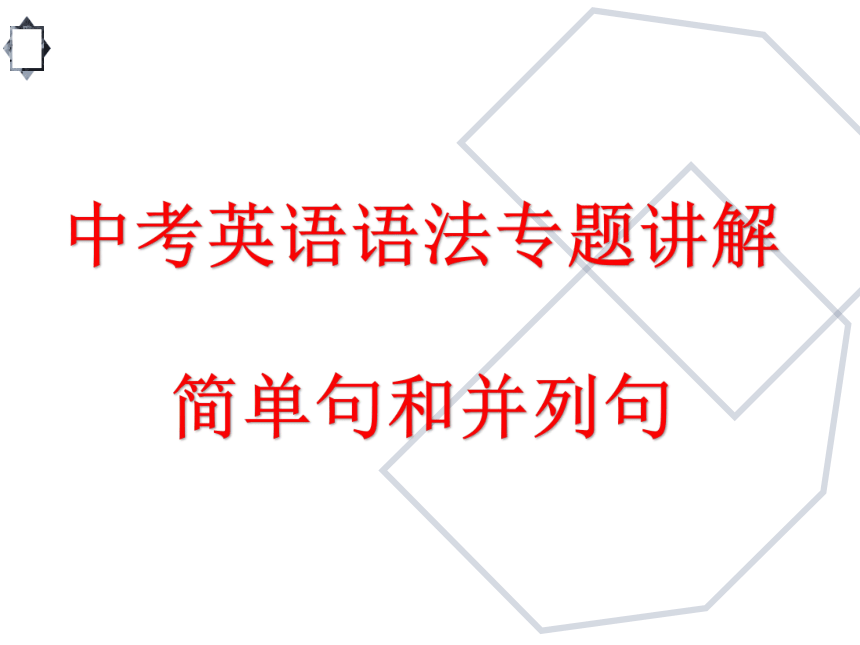 | |
| 格式 | zip | ||
| 文件大小 | 2.4MB | ||
| 资源类型 | 教案 | ||
| 版本资源 | 通用版 | ||
| 科目 | 英语 | ||
| 更新时间 | 2019-10-01 20:38:19 | ||
图片预览

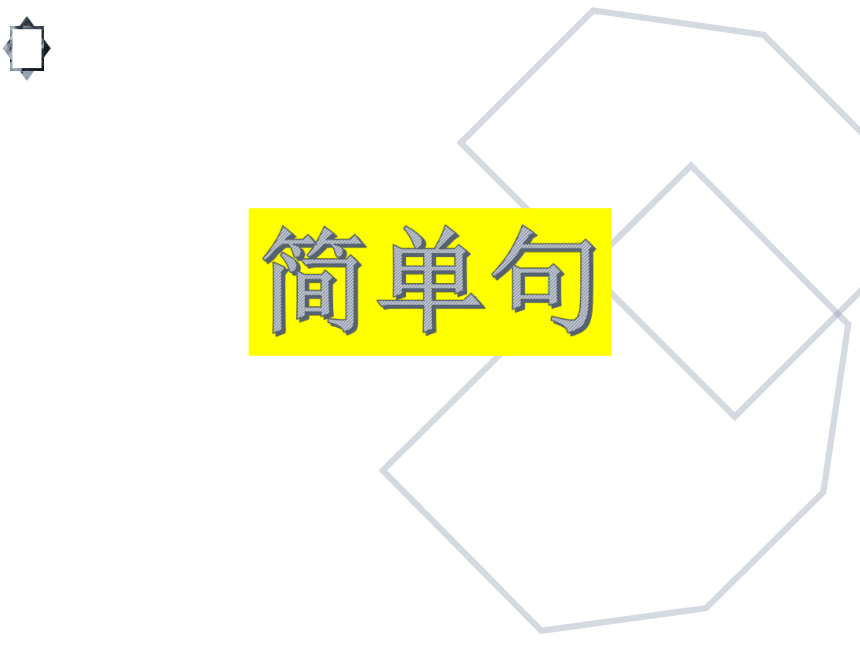
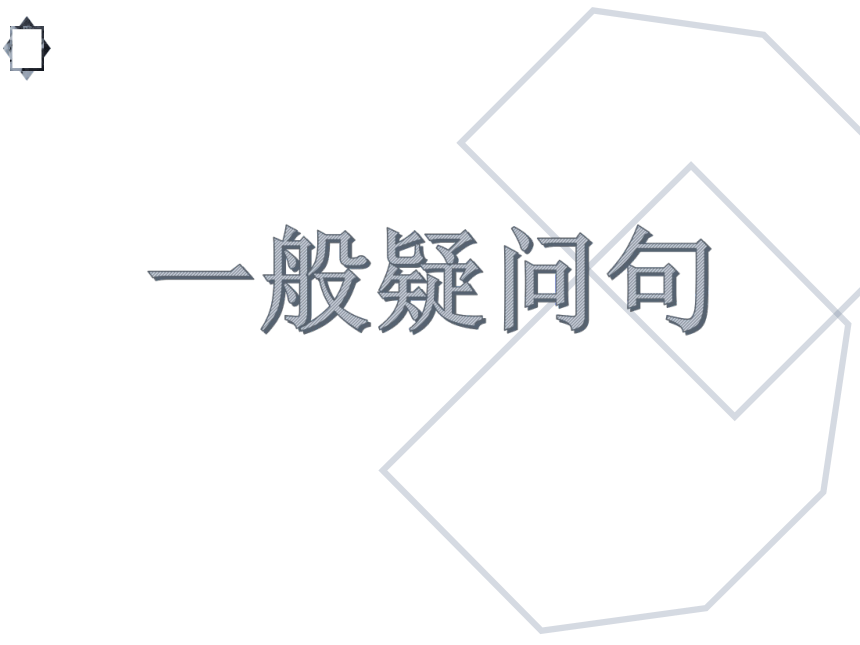
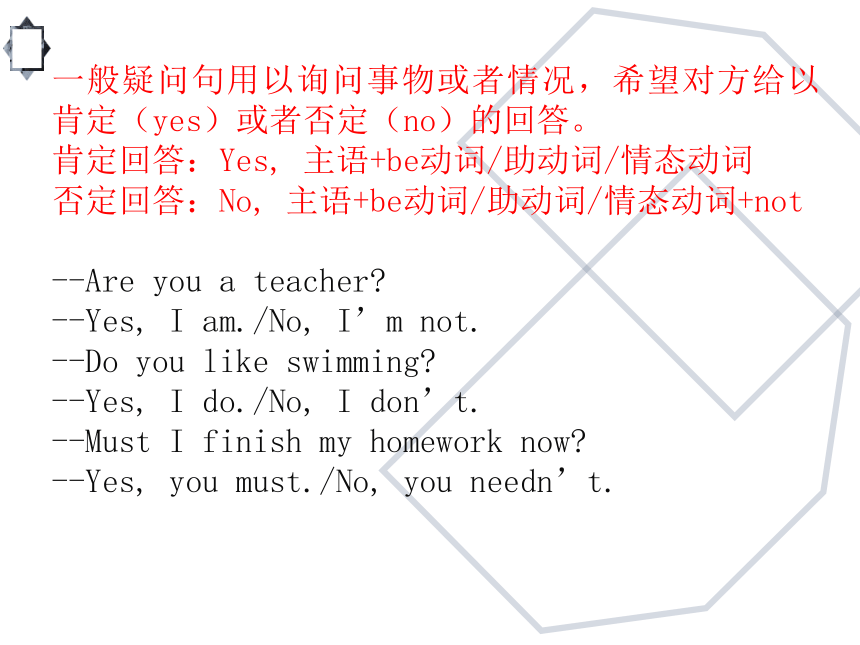
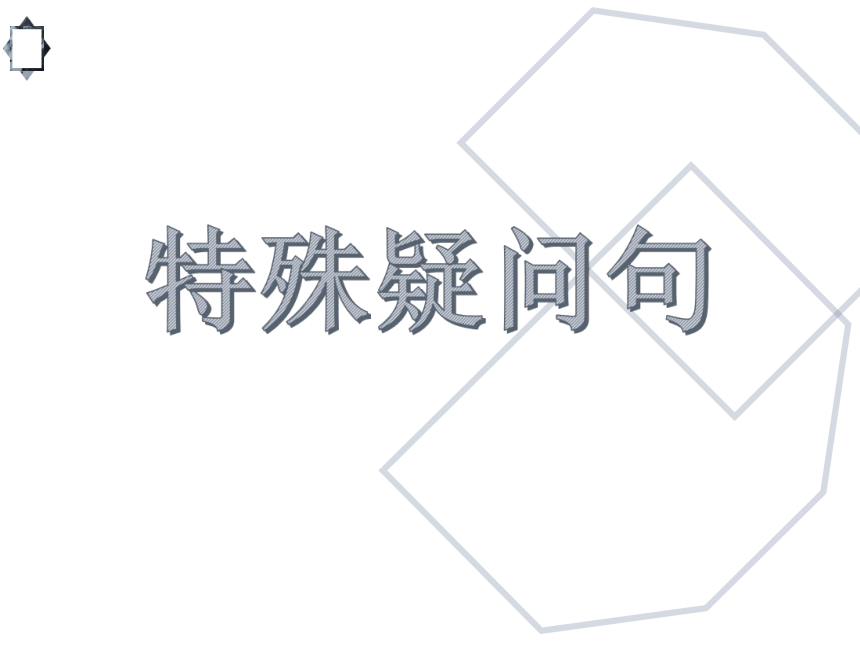
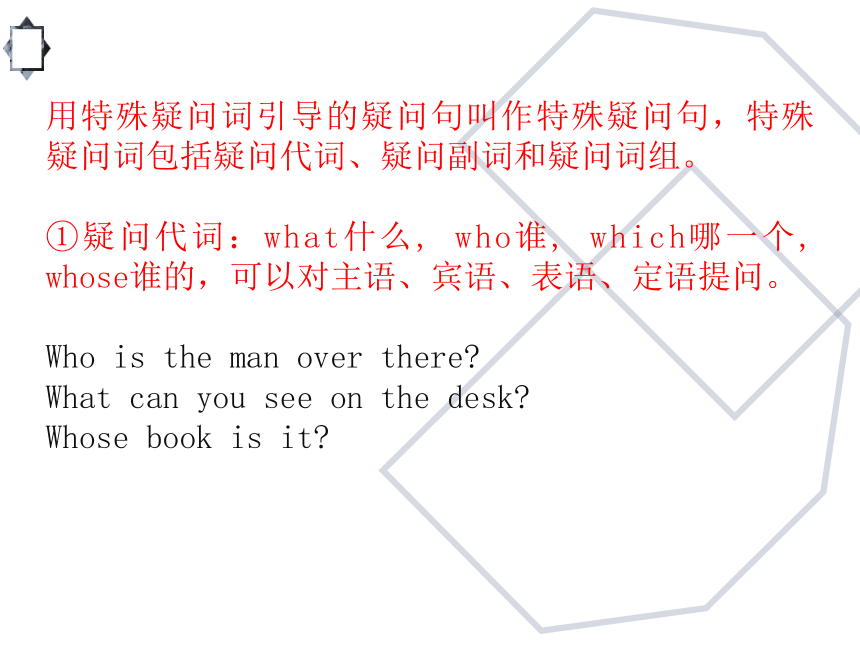
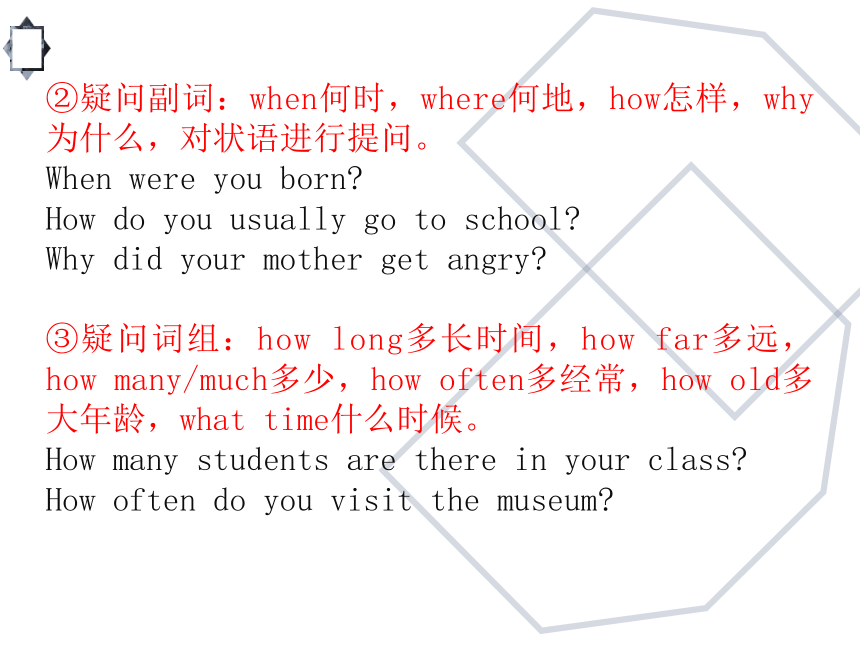
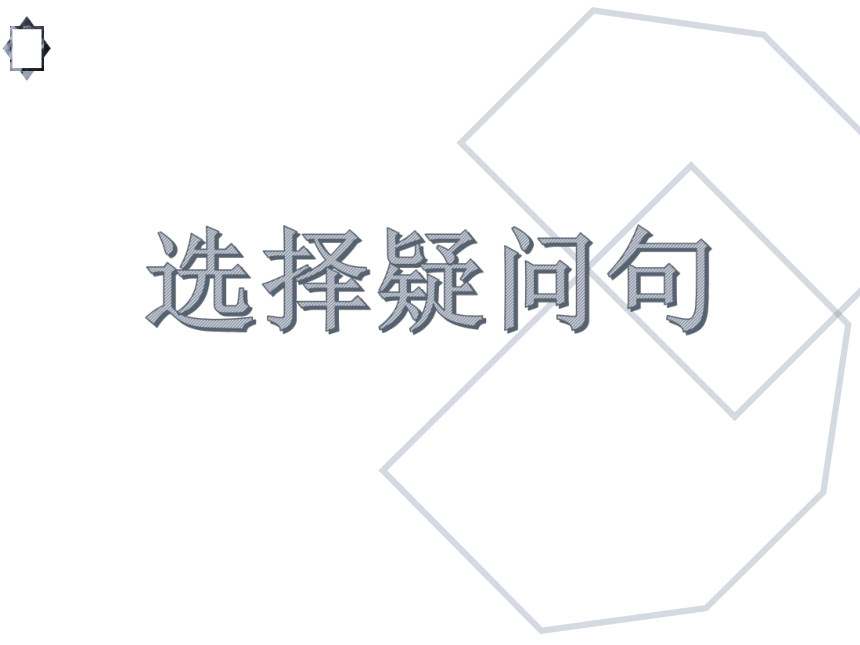
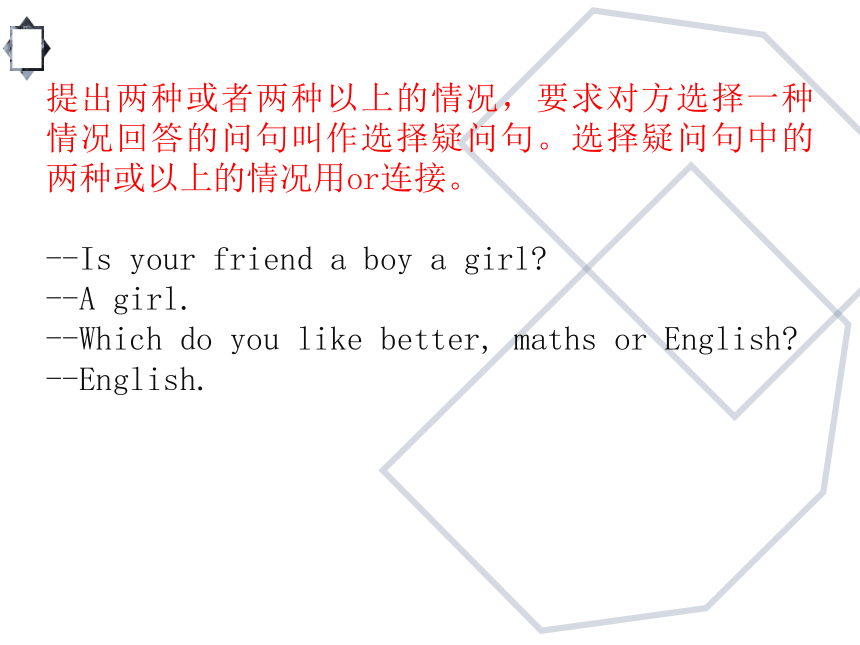
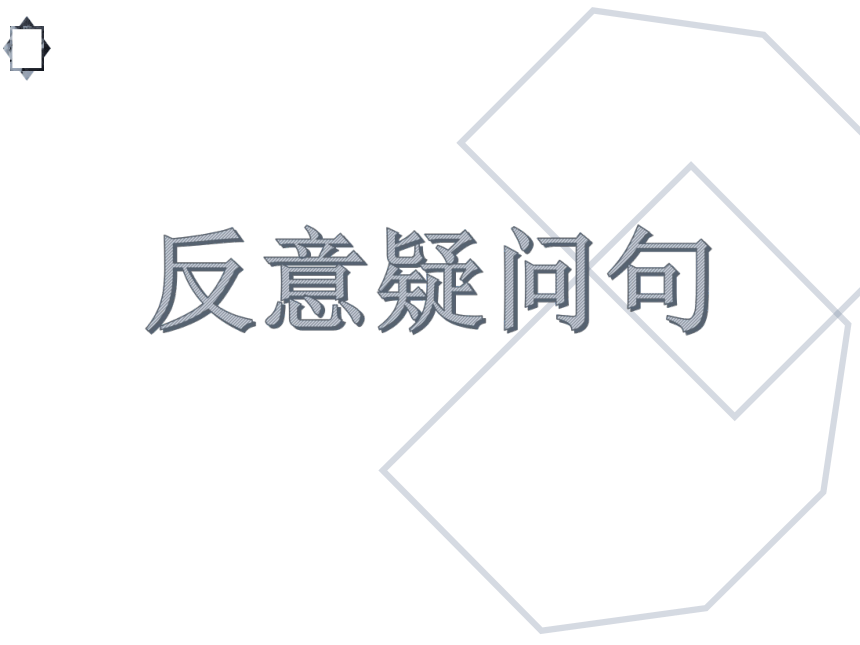
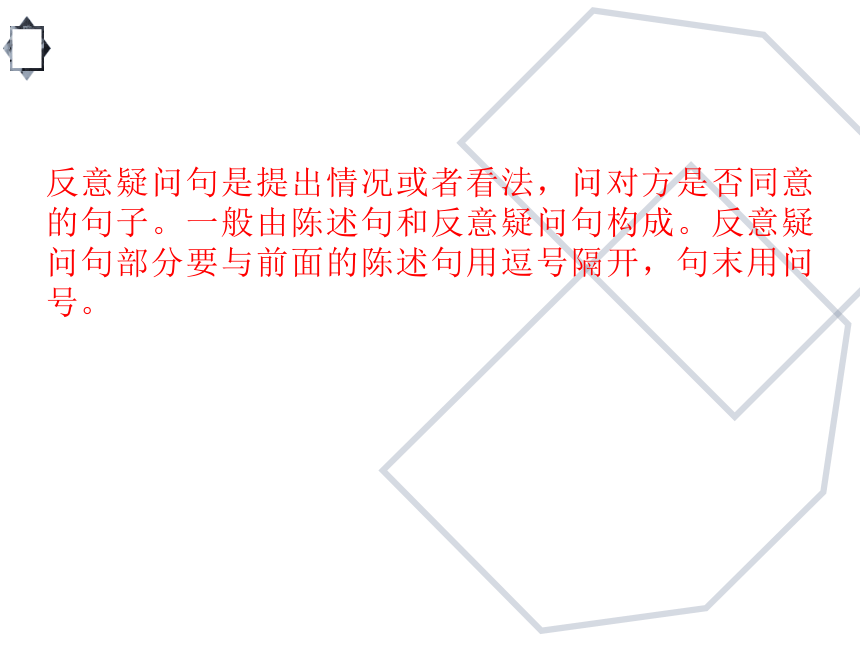
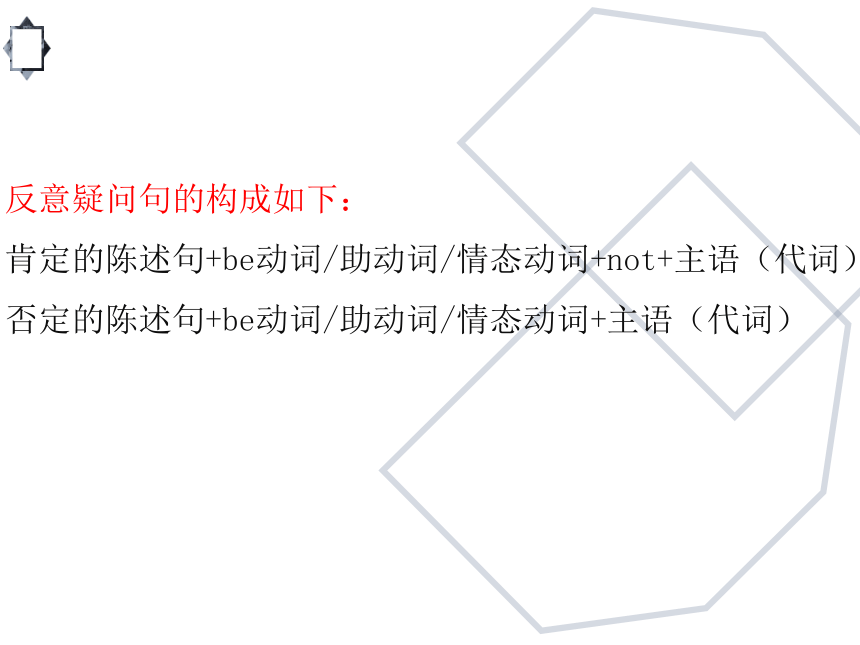
文档简介
(共36张PPT)
中考英语语法专题讲解
简单句和并列句
一般疑问句用以询问事物或者情况,希望对方给以肯定(yes)或者否定(no)的回答。
肯定回答:Yes, 主语+be动词/助动词/情态动词
否定回答:No, 主语+be动词/助动词/情态动词+not
--Are you a teacher?
--Yes, I am./No, I’m not.
--Do you like swimming?
--Yes, I do./No, I don’t.
--Must I finish my homework now?
--Yes, you must./No, you needn’t.
用特殊疑问词引导的疑问句叫作特殊疑问句,特殊疑问词包括疑问代词、疑问副词和疑问词组。
①疑问代词:what什么, who谁, which哪一个, whose谁的,可以对主语、宾语、表语、定语提问。
Who is the man over there?
What can you see on the desk?
Whose book is it?
②疑问副词:when何时,where何地,how怎样,why为什么,对状语进行提问。
When were you born?
How do you usually go to school?
Why did your mother get angry?
③疑问词组:how long多长时间,how far多远,how many/much多少,how often多经常,how old多大年龄,what time什么时候。
How many students are there in your class?
How often do you visit the museum?
提出两种或者两种以上的情况,要求对方选择一种情况回答的问句叫作选择疑问句。选择疑问句中的两种或以上的情况用or连接。
--Is your friend a boy a girl?
--A girl.
--Which do you like better, maths or English?
--English.
反意疑问句是提出情况或者看法,问对方是否同意的句子。一般由陈述句和反意疑问句构成。反意疑问句部分要与前面的陈述句用逗号隔开,句末用问号。
反意疑问句的构成如下:
肯定的陈述句+be动词/助动词/情态动词+not+主语(代词)
否定的陈述句+be动词/助动词/情态动词+主语(代词)
①陈述句部分含有never, few, little, nothing, nobody, no, hardly, none等表示否定意义的词时,反意疑问句部分用肯定形式。
He has few friends at school, does he?
注意:当陈述句谓语动词是含有否定意义的前缀的词时,反意疑问句部分还是要用否定形式。
He dislikes smoking, doesn’t he?
②陈述句部分是there be结构,反意疑问句用be there。
There is a book on the desk, isn’t there?
③当陈述句部分的主语是指物的不定代词,something, anything, everything等时,反意疑问句主语用it;如果主语是指人的不定代词somebody, anybody, everybody等时,反意疑问句主语用they或he。
Someone wants to see you, don’t they?
④ 当陈述句的主语是this,that时,反意疑问句主语用it;当陈述句的主语是these, those时,反意疑问句主句用they。
This is an interesting film, isn’t it?
Those aren’t banana trees, are they?
⑤ 当陈述句谓语动词含有have/has/had时,若时态为完成时态或者含有had better,反意疑问句用have/has/had,其它情况需要借助助动词构成反意疑问句。
Jack has a new watch, doesn’t he?
They had to get up early in the morning, didn’t they?
He has been to Beijing twice, hasn’t he?
We'd better stop talking, hadn’t we?
⑥ 当陈述句部分含有need时,如果need作行为动词,则反意疑问句部分用do/does/did,如果need作情态动词,则反意疑问句部分用need。
We need to buy a new washing machine, don’t we?
We needn’t set out at once, need we?
⑦ 当陈述句部分是肯定的祈使句,反意疑问句用will you或者won't you,当陈述句是否定的祈使句,反意疑问句用will you。
Pass me the salt, will/won’t you?
Don’t play football in the street, will you?
⑧ 当陈述部分是以let's开头的祈使句,反意疑问句用shall we;当陈述句部分是以let us开头的祈使句,反意疑问句用will you。
Let’s go shopping, shall we?
Let us have a look, will/won’t you?
⑨ 当陈述句含有must时,当must表示“必须”时,反意疑问句用needn't;当must表示“一定、想必”,反意疑问句部分的谓语应根据must后面的动词来确定。
They must come on time, needn’t they?
That man must be Mr. Zhang, isn’t he?
⑩ 当陈述句是主从复合句,反意疑问句的主语通常与主句的主语保持一致。
She said he would come tomorrow, didn’t she?
注意:若主句的主语是第一人称I/we,其谓语动词又是think, suppose, expect, believe, imagine等时,反意疑问句部分的主语和谓语和从句保持一致。
I don't think he is a good student, is he?
We think it is a good idea, isn’t it?
反意疑问句的回答
反意疑问句的回答要根据具体的情况来确定用肯定形式还是否定形式。
--Lucy is very good at skating, isn’t she?
--Yes, she is.
--You don’t like eating beef, do you?
--No, I don’t.
陈述句用来叙述一件事情或者表达一种想法,有肯定和否定两种形式。
My aunt works in a hospital.
I can’t ride a bike.
祈使句表示命令、请求、建议或者劝告,通常用动词原形开头,否定的祈使句在动词原形前加上not。
Come in!
Be quiet!
Don’t be late.
Don’t talk in class.
①what引导的感叹句
What+a/an+形容词+单数可数名词+(主语+谓语)!
What+形容词+复数可数名词+(主语+谓语)!
What+形容词+不可数名词+(主语+谓语)!
What a lovely dog (it is)!
What beautiful flowers (they are)!
What good news (it is)!
②how引导的感叹句
How+形容词或副词+主语+谓语!
How+形容词+a/an+单数可数名词+主语+谓语!
How+主语+谓语
How fast the boy runs!
How useful a subject it is!
How time flies!
使用并列连词连接起来的两个或两个以上的简单句叫作并列句。并列句的构成为:简单句+并列连词+简单句。
1、表示顺承、并列、递进关系的并列连词
and和,both...and...……和……都,as well as也,not only...but also...不但……而且……,neither...nor...既不……也不……等。
My father bought me a present, and I like it very much.
He can speak not only English but also French.
特别提醒:
and连接的两个并列成分的肯定句变为否定句时,and要变成or。
I can’t sing or dance.
2、表示转折和对比关系的并列连词
but但是,yet然而,while而
Lucy likes red while Lily likes white.
3、表示选择关系的并列连词
either...or...要么……要么……,or或者、否则
Study hard, or you’ll fail the exam.
Either you or he has made the mistake.
4、表示因果关系的并列连词
so所以、因此,for因为
Kate was ill, so she didn’t go to school.
It must have been wet last night, for the ground is wet.
中考英语语法专题讲解
简单句和并列句
一般疑问句用以询问事物或者情况,希望对方给以肯定(yes)或者否定(no)的回答。
肯定回答:Yes, 主语+be动词/助动词/情态动词
否定回答:No, 主语+be动词/助动词/情态动词+not
--Are you a teacher?
--Yes, I am./No, I’m not.
--Do you like swimming?
--Yes, I do./No, I don’t.
--Must I finish my homework now?
--Yes, you must./No, you needn’t.
用特殊疑问词引导的疑问句叫作特殊疑问句,特殊疑问词包括疑问代词、疑问副词和疑问词组。
①疑问代词:what什么, who谁, which哪一个, whose谁的,可以对主语、宾语、表语、定语提问。
Who is the man over there?
What can you see on the desk?
Whose book is it?
②疑问副词:when何时,where何地,how怎样,why为什么,对状语进行提问。
When were you born?
How do you usually go to school?
Why did your mother get angry?
③疑问词组:how long多长时间,how far多远,how many/much多少,how often多经常,how old多大年龄,what time什么时候。
How many students are there in your class?
How often do you visit the museum?
提出两种或者两种以上的情况,要求对方选择一种情况回答的问句叫作选择疑问句。选择疑问句中的两种或以上的情况用or连接。
--Is your friend a boy a girl?
--A girl.
--Which do you like better, maths or English?
--English.
反意疑问句是提出情况或者看法,问对方是否同意的句子。一般由陈述句和反意疑问句构成。反意疑问句部分要与前面的陈述句用逗号隔开,句末用问号。
反意疑问句的构成如下:
肯定的陈述句+be动词/助动词/情态动词+not+主语(代词)
否定的陈述句+be动词/助动词/情态动词+主语(代词)
①陈述句部分含有never, few, little, nothing, nobody, no, hardly, none等表示否定意义的词时,反意疑问句部分用肯定形式。
He has few friends at school, does he?
注意:当陈述句谓语动词是含有否定意义的前缀的词时,反意疑问句部分还是要用否定形式。
He dislikes smoking, doesn’t he?
②陈述句部分是there be结构,反意疑问句用be there。
There is a book on the desk, isn’t there?
③当陈述句部分的主语是指物的不定代词,something, anything, everything等时,反意疑问句主语用it;如果主语是指人的不定代词somebody, anybody, everybody等时,反意疑问句主语用they或he。
Someone wants to see you, don’t they?
④ 当陈述句的主语是this,that时,反意疑问句主语用it;当陈述句的主语是these, those时,反意疑问句主句用they。
This is an interesting film, isn’t it?
Those aren’t banana trees, are they?
⑤ 当陈述句谓语动词含有have/has/had时,若时态为完成时态或者含有had better,反意疑问句用have/has/had,其它情况需要借助助动词构成反意疑问句。
Jack has a new watch, doesn’t he?
They had to get up early in the morning, didn’t they?
He has been to Beijing twice, hasn’t he?
We'd better stop talking, hadn’t we?
⑥ 当陈述句部分含有need时,如果need作行为动词,则反意疑问句部分用do/does/did,如果need作情态动词,则反意疑问句部分用need。
We need to buy a new washing machine, don’t we?
We needn’t set out at once, need we?
⑦ 当陈述句部分是肯定的祈使句,反意疑问句用will you或者won't you,当陈述句是否定的祈使句,反意疑问句用will you。
Pass me the salt, will/won’t you?
Don’t play football in the street, will you?
⑧ 当陈述部分是以let's开头的祈使句,反意疑问句用shall we;当陈述句部分是以let us开头的祈使句,反意疑问句用will you。
Let’s go shopping, shall we?
Let us have a look, will/won’t you?
⑨ 当陈述句含有must时,当must表示“必须”时,反意疑问句用needn't;当must表示“一定、想必”,反意疑问句部分的谓语应根据must后面的动词来确定。
They must come on time, needn’t they?
That man must be Mr. Zhang, isn’t he?
⑩ 当陈述句是主从复合句,反意疑问句的主语通常与主句的主语保持一致。
She said he would come tomorrow, didn’t she?
注意:若主句的主语是第一人称I/we,其谓语动词又是think, suppose, expect, believe, imagine等时,反意疑问句部分的主语和谓语和从句保持一致。
I don't think he is a good student, is he?
We think it is a good idea, isn’t it?
反意疑问句的回答
反意疑问句的回答要根据具体的情况来确定用肯定形式还是否定形式。
--Lucy is very good at skating, isn’t she?
--Yes, she is.
--You don’t like eating beef, do you?
--No, I don’t.
陈述句用来叙述一件事情或者表达一种想法,有肯定和否定两种形式。
My aunt works in a hospital.
I can’t ride a bike.
祈使句表示命令、请求、建议或者劝告,通常用动词原形开头,否定的祈使句在动词原形前加上not。
Come in!
Be quiet!
Don’t be late.
Don’t talk in class.
①what引导的感叹句
What+a/an+形容词+单数可数名词+(主语+谓语)!
What+形容词+复数可数名词+(主语+谓语)!
What+形容词+不可数名词+(主语+谓语)!
What a lovely dog (it is)!
What beautiful flowers (they are)!
What good news (it is)!
②how引导的感叹句
How+形容词或副词+主语+谓语!
How+形容词+a/an+单数可数名词+主语+谓语!
How+主语+谓语
How fast the boy runs!
How useful a subject it is!
How time flies!
使用并列连词连接起来的两个或两个以上的简单句叫作并列句。并列句的构成为:简单句+并列连词+简单句。
1、表示顺承、并列、递进关系的并列连词
and和,both...and...……和……都,as well as也,not only...but also...不但……而且……,neither...nor...既不……也不……等。
My father bought me a present, and I like it very much.
He can speak not only English but also French.
特别提醒:
and连接的两个并列成分的肯定句变为否定句时,and要变成or。
I can’t sing or dance.
2、表示转折和对比关系的并列连词
but但是,yet然而,while而
Lucy likes red while Lily likes white.
3、表示选择关系的并列连词
either...or...要么……要么……,or或者、否则
Study hard, or you’ll fail the exam.
Either you or he has made the mistake.
4、表示因果关系的并列连词
so所以、因此,for因为
Kate was ill, so she didn’t go to school.
It must have been wet last night, for the ground is wet.
同课章节目录
- 词法
- 名词
- 动词和动词短语
- 动词语态
- 动词时态
- 助动词和情态动词
- 非谓语动词
- 冠词
- 代词
- 数词和量词
- 形容词副词及其比较等级
- 介词和介词短语
- 连词和感叹词
- 构词法
- 相似、相近词比较
- 句法
- 陈述句
- 一般疑问句和否定疑问句
- 特殊疑问句及选择疑问句
- 反意疑问句
- 存在句(There be句型)
- 宾语从句
- 定语从句
- 状语从句
- 主谓一致问题
- 简单句
- 并列句
- 复合句
- 主谓一致
- 主、表语从句
- 名词性从句
- 直接引语和间接引语
- 虚拟语气
- 感叹句
- 强调句
- 倒装句
- 祈使句
- 句子的成分
- 句子的分类
- 题型专区
- 单项选择部分
- 易错题
- 完形填空
- 阅读理解
- 词汇练习
- 听说训练
- 句型转换
- 补全对话
- 短文改错
- 翻译
- 书面表达
- 任务型阅读
- 语法填空
- 其他资料
